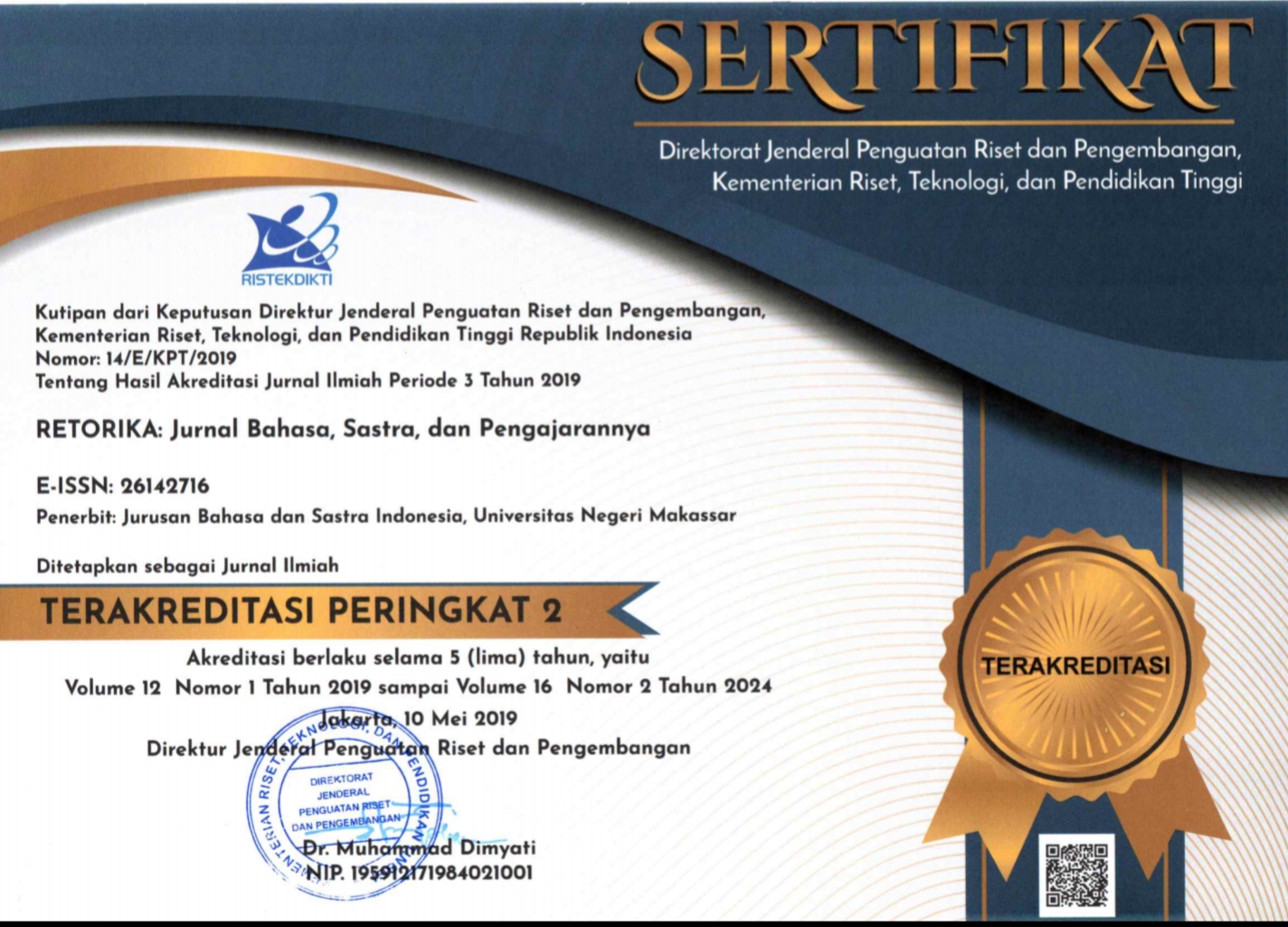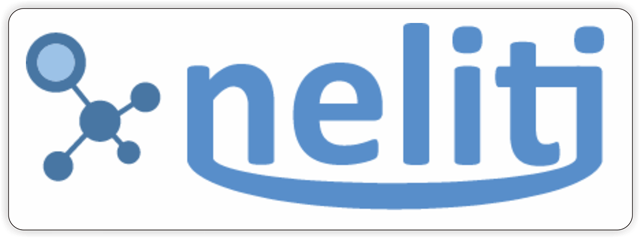HOMOGRAPHS BETWEEN INDONESIAN AND THAI: CONTRASTIVE ANALYSIS
(1) Institut Agama Islam Negeri Ponorogo
(2) Universitas Islam Malang
(3) Balai Bahasa Provinsi Jawa Timur
(4) Universitas Islam Negeri Sayyid Ali Rahmatullah Tulungagung
(5) Bansomdetchaopraya Rajabhat University of Thailand
(*) Corresponding Author
DOI: https://doi.org/10.26858/retorika.v17i1.37716
Abstract
This research aims to describe the forms and expressions of understanding in Indonesian and Thai with a focus on homographs. The techniques used in this research are observation and note taking techniques. To achieve this goal, the listening method was used in data collection with note-taking techniques, namely observing, listening and recording vocabulary. Next, classify Indonesian vocabulary and Thai vocabulary. Next, to analyze Indonesian vocabulary and Thai vocabulary, this was done by comparing the similarities between the forms of expression and meaning of vocabulary in Indonesian with vocabulary in Thai and then classifying them. The data source was obtained through interactions between students in language learning in Thai students' classes and then compared with Indonesian. The research results show that there are two types of homographs, namely, the same meaning and pronunciation, and the same pronunciation and different meaning.
Keywords
Full Text:
PDFReferences
Ahmad, Humza., & Erdodi, Laszlo. (2020). Overview of Phishing Landscape and Homographs in Arabic Domain Names. Security and Privacy, 4(4), e159. wileyonlinelibrary.com/journal/spy2. DOI: 10.1002/spy2.159. p.1 of 14.
Al Midhwah, A., & Alhawary, M.T. (2020). Arabic Diacritics and Their Role in Facilitating Reading Speed, Accuracy, and Comprehension by English L2 Learners of Arabic. The Modern Language Journal, 104(2), 418–438. http://www.jstor.org/stable/45286670.
Arifni, ED, & Engliana, E. (2021). Stylistic and Linguistic Equivalence in Translating the Prepositions 'In', 'On', and 'At' in English Novels into Indonesian. JEdu: Journal of English Language Education, 1(2), 62–71. https://doi.org/10.30998/JEDU.V1I2.4131.
Aswan, A., Idris, NS, & Widia, I. (2021). Comparison of Indonesian Personal Pronouns with Malaysian: A Semantic Overview. Diksi, 29(2), 195–204. https://doi.org/10.21831/Diksi.V29I2.43034.
Chaer, A. (2002). Introduction to Indonesian Semantics. Jakarta: Rineka Cipta.
Chaer, A. & L.A. (2003). Early Introductory Sociolinguistics. Jakarta: Rineka Cipta.
Che, R. (2007). Comparison of Vocabulary in Indonesian with Pattani Malay Vocabulary in Thailand. Muhammadia University Surakarta. http://eprints.ums.ac.id/10482.
Davis, D. F., & Herr, P. M. (2014). From Bye to Buy: Homophones as a Phonological Route to Priming. Journal of Consumer Research, 40(6), 1063–1077. https://doi.org/10.1086/673960.
Guan, M. F. Li., & Xue, Y. (2024). Enhanced Syntactic and Semantic Graph Convolutional Network With Contrastive Learning for Aspect-Based Sentiment Analysis. in IEEE Transactions on Computational Social Systems, 11 (1), pp. 859-870, Feb. 2024, doi: 10.1109/TCSS.2023.3296476.
Hasi & Nasun. (2012). The Design and Application of Mongolian Homograph Words Information DIctionary. Fifth International Conference on Intelligent Networks and Intelligent Systems, Tianjin, China, 2012, pp. 224-227, doi: 10.1109/ICINIS.2012.12.
Hernandez, A. E. (2013). [Review of The Psycholinguistics of Bilingualism, by F. Grosjean & P. Li]. Language, 89(4), 963–966. http://www.jstor.org/stable/24671966.
Jacobson, J., Lapp, D., & Flood, J. (2007). A Seven-Step Instructional Plan for Teaching English-Language Learners to Comprehend and Use Hemonyms, Homophones, and Homographs. Journal of Adolescent & Adult Literacy, 51(2), 98–111. http://www.jstor.org/stable/40021840.
Jeong, HI, Song, J., Choi, EY, Kim, SH, Huh, J., Kang, IS, Yang, JH, & Jun, TG (2017). How Long Can Further Intervention Be Delayed After Balloon Dilatation of The Homograft in The Lung Position? Korean Journal of Circulation, 47(5), 786–793. https://doi.org/10.4070/KCJ.2017.0033
Kengmalaphi, N., & Mualimin, M. (2022). Comparison of Patani (Thai) Malay Vocabulary between the Yala and Menara Dialects in the Community Realm.. Anuva: Jurnal Kajian Budaya, Perpustakaan, dan Informasi, 6(2), 173-178.
Kusmiatun, A., & Bo, F. (2021). Euphemisms in Indonesian and Mandarin: Contrastive Linguistic Analysis. Retorika: Jurnal Bahasa, Sastra, dan Pengajarannya, 14(2) 166-176. https://doi.org/10.26858/retorika.v14i2.14199.
Kuswardayan, I., Tjahyanto, A., & Siregar, KMS (2004). Indonesian Word Pronunciation Software Based on Word Fragmentation with Finite State Automata. JUTI: Scientific Journal of Information Technology, 3(1). https://doi.org/10.12962/j24068535.v3i1.a133.
Lailatul Fithriyah Azzakiyah, L. (2020). Homonymy and Phonetic Ambiguity in Mahalabiu. Journal of Language, Literature and Learning, 10(2), 243. https://doi.org/10.20527/JBSP.V10I2.9379
Lestari, Oktavia Winda, Jazeri Mohamad, & Kareng, SK (2022). Synonymous and Homonymous Words in Patani Malay and Indonesian in IAIN Tulungagung Student Interactions. Estetik: Jurnal Bahasa Indonesia, 5(1), 43-60.
Lin, N.Y. Fu, X. Lin, D. Zhou, A. Yang & S. Jiang. (2023). CL-XABSA: Contrastive Learning for Cross-Lingual Aspect-Based Sentiment Analysis. in IEEE/ACM Transactions on Audio, Speech, and Language Processing, Vol. 31, pp. 2935-2946, 2023, doi: 10.1109/TASLP.2023.3297964.
Long, T. (2018). Contrastive Analysis of Thai and Indonesian Phonology. Muhammadiyah University Makassar. https://digilibadmin.unismuh.ac.id/upload/4470-Full_Text.pdf.
Machu, M. (2021). Comparison of Indonesian Word Classes with Southern Thai Malay. Edu-Kata, 7(1), 39-48.
Maiseng, F. (2019). Contrastive Analysis of the Conjunction of Thai with Indonesian. Muhammadiyah University of North Sumatra. http://repository.umsu.ac.id/bitstream/handle/123456789/6013/Skripsi Miss Faseeera Maiseng.pdf;jsessionid=96614398406F62AAD2F25DB7C53F8C9E?sequence=1.
Mirantee, W. (2021). Contrastive Study of the Syntactic Levels of Indonesian and Thai Languages and Their Use for Syntactic Enrichment Books at BIPA Thailand. Indonesian Education University. http://repository.upi.edu/65707.
Morford, J.P., Kroll, J.F., Piñar, P., & Wilkinson, E. (2014). Bilingual Word Recognition in Deaf and Hearing Signers: Effects of Proficiency and Language Dominance on Cross-Language Activation. Second Language Research, 30(2), 251–271. http://www.jstor.org/stable/44280136.
Nadaraning, A., Sofyan, A., & S, ER (2016). Comparison of Indonesian and Thai Conjunctions. Cultural Publica, 1(1), 1–11. http://repository.unej.ac.id/bitstream/handle/123456789/78935/AbdunlohNadaraning.pdf?sequence=1.
Natasuwarna, AP (2020). Support Vector Machine Feature Selection in Online Learning Sustainability Sentiment Analysis. Techno.Com, 19(4), 437–448. https://doi.org/10.33633/TC.V19I4.4044.
Nurlinda. (2018). Representation of the Use of Homographs in Makassar Language in the Limbung Community. Muhammadiyah University Makassar. https://digilibadmin.unismuh.ac.id/upload/29773-Full_Text.pdf.
Restiasih. (2017). Ambiguity of Meaning in the Study of Logic. Surabaya City Education E-Journal, 1(1).
Riahi, N., & Sedghi, F. (2012). A Semi-Supervised method for Persian Homograph Disambiguation. 20th Iranian Conference on Electrical Engineering (ICEE2012), Tehran, Iran, 2012, pp. 748-751, doi: 10.1109/IranianCEE.2012.6292453.
Salleh, SF, Yahya, Y., Subet, MF, & Daud, MZ (2020). Lexical Semantic Analysis in the Novel Sangkar by Samsiah Mohd. Neither is it. Asian People's Journal (APJ), 3(1), 45–63. https://doi.org/10.37231/APJ.2020.3.1.144.
Shaputra, FC, Muhaiban, & Alfan, M. (2021). Comparison of Arabic Language Textbooks for Class X MA Indonesia and 4 Matayoum Thailand Based on the Views of Rusydi Ahmad Thu'aimah. JoLLA: Journal of Language, Literature, and Arts, 1(3), 397–415. https://doi.org/10.17977/UM064V1I32021P397-415.
Sumiyani, S. (2019). Idiolect Use of Thai into Indonesian among Thai Students at Muhammadiyah University, Tangerang. Silampari Bisa: Journal of Indonesian, Regional and Foreign Language Education Research, 2(1), 90–107. https://doi.org/10.31540/silamparibisa.v2i1.355.
Wang, Wern Jun., Hwang, Shaw Hwa., & Chen, Sin Horng. (1996). The broad study of homograph disambiguity for Mandarin speech synthesis. Proceedings of the Fourth International Conference on Spoken Language Processing. ICSLP '96, Philadelphia, PA, USA, 1996, pp. 1389-1392 vol.3, doi: 10.1109/ICSLP.1996.607873.
Wijaya & Rohmadi Muhammad. (2011). Semantic Theory and Analysis. Yumalibrary.
Xiao, R., &肖忠華. (2015). Contrastive Corpus Linguistic Studies Of English And Chinese: The Cases Of Passive Constructions And Classifiers. Journal of Chinese Linguistics Monograph Series, 25, 82–114. https://www.jstor.org/stable/26455280.
Yan Khiong, B. (2021). Comparative Analysis of Sentence Patterns in Mandarin and Indonesian. Paramasastra, 8(2), 180–186. https://doi.org/10.26740/Paramasastra.V8N2.P180-186.
Zultiyanti, Z. (2021). Comparison of Indonesian and Javanese Phonetics: An Initial Observation. Code: Language Journal, 10(4). https://doi.org/10.24114/KJB.V10I4.30731.
Article Metrics
Abstract view : 245 times | PDF view : 57 timesRefbacks
- There are currently no refbacks.
Copyright (c) 2024 Moh Mukhlas, Oktavia Winda Lestari, Krismonika Khoirunnisa, Fakhriyyah Asmay Aidha, Wisaruta Butsaman

This work is licensed under a Creative Commons Attribution-NonCommercial 4.0 International License.
Published by:
Department of Indonesian Language, Faculty of Languages and Literature, Universitas Negeri Makassar in cooperate with Asosiasi Dosen Bahasa dan Sastra Indonesia (ADOBSI) and Ikatan Program Studi Pendidikan Bahasa dan Sastra Indonesia (IKAPROBSI).
Address: Department of Indonesian Language Office, DG Building Second Floor, UNM Parangtambung, Daeng Tata Raya Street, Makassar, South Sulawesi, Indonesia
 Email: [email protected]
Email: [email protected]

RETORIKA: Jurnal Bahasa, Sastra,dan Pengajarannya is licensed under a Creative Commons Attribution-NonCommercial 4.0 International License.
















